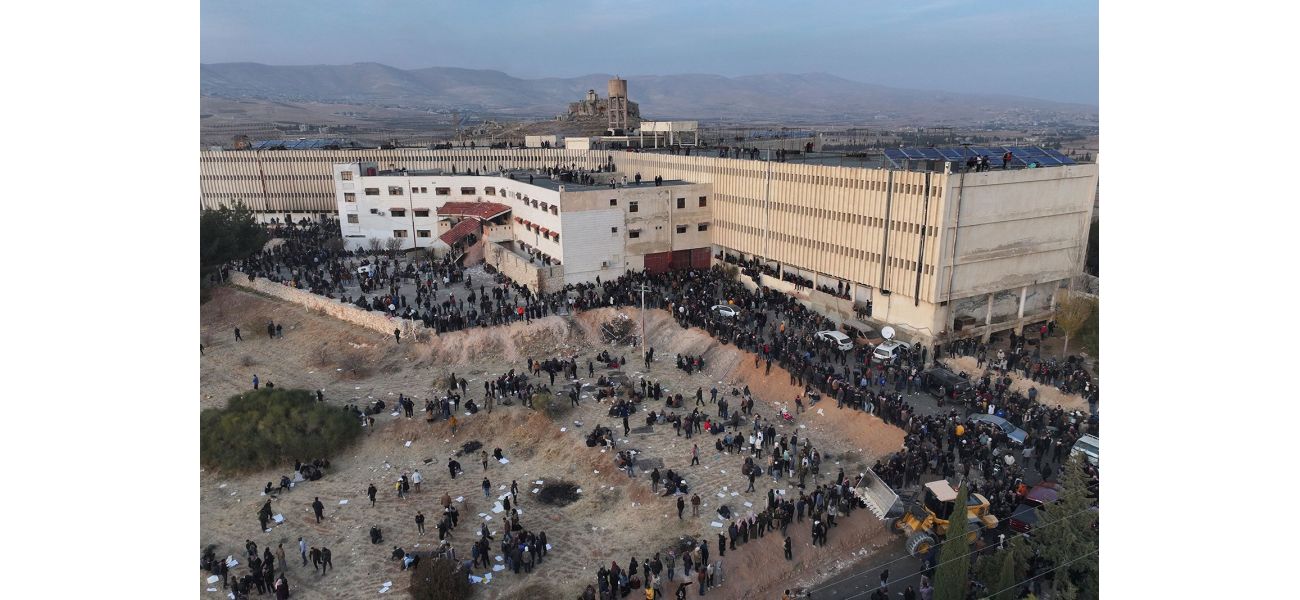'Slaughterhouse' prison in Syria known for its inhumane conditions and brutal treatment of prisoners.
Syrians celebrate, but also desperately search for loved ones who were forcibly disappeared by Assad's regime.
December 10th 2024.

As the people of Syria celebrated this week, there was also a sense of urgency as they searched for their missing loved ones who had been forcibly taken during Bashar al-Assad's brutal dictatorship. The notorious Saydnaya prison, known for its arbitrary detention, torture, and murder, has become a focal point for these searches.
Under the blazing sun, crowds of people made their way to the infamous prison located north of Damascus. The roads were congested with traffic for miles and some even left their cars to walk the last stretch uphill, passing barbed wire fences and watchtowers. The prison, once a symbol of fear and oppression, now stood as a stark reminder of the atrocities committed by the Assad regime.
Just as the opulent wealth and lavish lifestyle of Assad and his family were revealed through their palaces, the horrors of his prisons have also been exposed. These detention facilities, known as black holes, have been used to disappear anyone who dared to oppose the regime since the 1970s. Saydnaya was one of the most notorious, with Amnesty International reporting that up to 13,000 people were executed there between 2011 and 2015.
Unsurprisingly, when rebel fighters took control of Damascus and forced Assad to flee to Russia, Saydnaya was one of the first places they focused on. As images of released prisoners emerged, many Syrians took to social media in a desperate attempt to locate their loved ones who had been missing for years.
By Monday, the desperation had reached a tipping point and people took matters into their own hands by storming the prison. Rumors spread that there were still thousands of people imprisoned in the underground "red section" of the facility. The fear of never finding their missing loved ones fueled the crowds as they searched every corner of the prison.
When CNN arrived on the scene, they found a massive crowd gathered both outside and inside the prison. The air was filled with cries of "Allahu Akbar" and the sound of celebratory gunfire. One woman, Maysoon Labut, had come all the way from Dara'a, the city where the anti-regime protests began during the Arab Spring. She was searching for her three brothers and son-in-law and her desperation was evident as she pleaded for help.
There were rumors that the "red section" was buried deep within the prison, causing further panic among the families searching for their loved ones. However, it is still unclear if this area even exists, leaving many with the fear that they may never find their missing family members.
The Syrian Civil Defense, also known as the White Helmets, sent special teams to the prison to search for any hidden cells. As rebel fighters urged the crowds to be quiet in the hopes of hearing any voices of trapped detainees, a sense of hope fell over the crowd. But unfortunately, no entrance was found.
In a statement, the White Helmets confirmed that they had found no evidence of secret cells or hidden areas within the prison. They urged people to stop spreading misinformation on social media. The Association of Detainees and the Missing in Saydnaya Prison also stated that all prisoners had been released by Sunday afternoon and that claims of people being trapped underground were unfounded.
Mounir Al-Fakir, a former Saydnaya detainee and founding partner of ADMSP, believes that there is only one underground level of cells and doubts the existence of any hidden layers below. He estimates that around 3,000 detainees were released after the liberation of Damascus. However, the families searching through the prison on Monday, sifting through documents and using flashlights in the darkness, show the agonizing wait they have endured for years with no knowledge of their loved ones' whereabouts.
One woman held up a photo of her brother, taken 12 years ago, with no information on his fate. Another man, Suheil Hamawi, spent over 30 years imprisoned in various Syrian jails and finally returned home to Lebanon on Monday. While he was overjoyed to be reunited with his family, he also realized the years he had missed and the precious time he would never get back.
The release of these prisoners is bittersweet for their families, knowing the suffering they endured for so long. But for now, they can finally find some closure and begin to heal from the trauma of their loved ones' forced disappearances.
Under the blazing sun, crowds of people made their way to the infamous prison located north of Damascus. The roads were congested with traffic for miles and some even left their cars to walk the last stretch uphill, passing barbed wire fences and watchtowers. The prison, once a symbol of fear and oppression, now stood as a stark reminder of the atrocities committed by the Assad regime.
Just as the opulent wealth and lavish lifestyle of Assad and his family were revealed through their palaces, the horrors of his prisons have also been exposed. These detention facilities, known as black holes, have been used to disappear anyone who dared to oppose the regime since the 1970s. Saydnaya was one of the most notorious, with Amnesty International reporting that up to 13,000 people were executed there between 2011 and 2015.
Unsurprisingly, when rebel fighters took control of Damascus and forced Assad to flee to Russia, Saydnaya was one of the first places they focused on. As images of released prisoners emerged, many Syrians took to social media in a desperate attempt to locate their loved ones who had been missing for years.
By Monday, the desperation had reached a tipping point and people took matters into their own hands by storming the prison. Rumors spread that there were still thousands of people imprisoned in the underground "red section" of the facility. The fear of never finding their missing loved ones fueled the crowds as they searched every corner of the prison.
When CNN arrived on the scene, they found a massive crowd gathered both outside and inside the prison. The air was filled with cries of "Allahu Akbar" and the sound of celebratory gunfire. One woman, Maysoon Labut, had come all the way from Dara'a, the city where the anti-regime protests began during the Arab Spring. She was searching for her three brothers and son-in-law and her desperation was evident as she pleaded for help.
There were rumors that the "red section" was buried deep within the prison, causing further panic among the families searching for their loved ones. However, it is still unclear if this area even exists, leaving many with the fear that they may never find their missing family members.
The Syrian Civil Defense, also known as the White Helmets, sent special teams to the prison to search for any hidden cells. As rebel fighters urged the crowds to be quiet in the hopes of hearing any voices of trapped detainees, a sense of hope fell over the crowd. But unfortunately, no entrance was found.
In a statement, the White Helmets confirmed that they had found no evidence of secret cells or hidden areas within the prison. They urged people to stop spreading misinformation on social media. The Association of Detainees and the Missing in Saydnaya Prison also stated that all prisoners had been released by Sunday afternoon and that claims of people being trapped underground were unfounded.
Mounir Al-Fakir, a former Saydnaya detainee and founding partner of ADMSP, believes that there is only one underground level of cells and doubts the existence of any hidden layers below. He estimates that around 3,000 detainees were released after the liberation of Damascus. However, the families searching through the prison on Monday, sifting through documents and using flashlights in the darkness, show the agonizing wait they have endured for years with no knowledge of their loved ones' whereabouts.
One woman held up a photo of her brother, taken 12 years ago, with no information on his fate. Another man, Suheil Hamawi, spent over 30 years imprisoned in various Syrian jails and finally returned home to Lebanon on Monday. While he was overjoyed to be reunited with his family, he also realized the years he had missed and the precious time he would never get back.
The release of these prisoners is bittersweet for their families, knowing the suffering they endured for so long. But for now, they can finally find some closure and begin to heal from the trauma of their loved ones' forced disappearances.
[This article has been trending online recently and has been generated with AI. Your feed is customized.]
[Generative AI is experimental.]
0
0
Submit Comment





